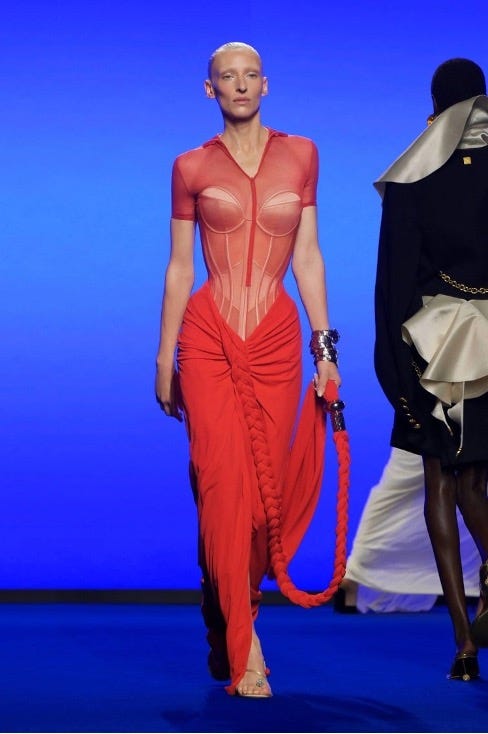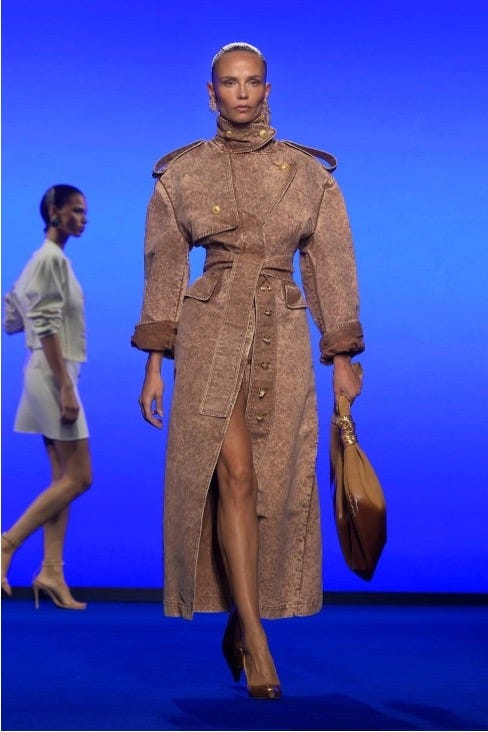Schiaparelli Spring/Summer 2025 Show: how the Future Vintage showcase was a tribute to the history of fashion
Schiaparelli's Spring/Summer 2025 Show displayed Daniel Roseberry's beautiful homage to vintage fashion as well as his appreciation for the women who created it.
Schiaparelli’s Spring/Summer 2025 show debuted in Paris on September 26th, 2024. The show left viewers with a sense of nostalgia for vintage 60s and 70s-inspired outfits and a hope for future generations to inherit and learn from past fashion trends.
The show was titled “Future Vintage,” coined by Daniel Roseberry himself. In his mission statement, Roseberry stated, “At the beginning of this collection, we decided we were going to make clothes not just for our clients, but for their daughters and granddaughters. Future Vintage, I’m calling it.”
The Future Vintage Ready-To-Wear showcase also only has female models. While some showcases have a mix of male and female models to signify the unisex yet ungendered aspect of the clothes, Schiaparelli purposely chose only female models for his showcase of their contribution to fashion throughout the years. “This collection, like all my work, owes everything to the women who brought it to life.”
This show displayed a vibrant combination of outfits that display timeless pieces that can be passed down through generations. Roseberry uses this show to display the lively history of fashion articles and statement pieces spanning centuries. Exaggerated rounded shoulders signify power dressing in the 1970s. At the same time, oversized faded blue cotton cape dresses and extra wide stand-up collar jackets portray a combination of the Middle Ages and the early 19th century. There are also ecru satin corsets disguised underneath red polo shirt mesh bodysuits and a raw denim bustier paired with a contrasting sculptural halter neck maxi dress present corsets and bustier, signifying the Victorian era.
These outfits draw inspiration from past centuries, blending vintage fashion with a modern twist. Here are some outfits from the Schiaparelli Spring/Summer 2025 showcase that pay a necessary homage to vintage fashion and fashion history that paved the way for future fashion:
Pointed Toe Shoes and 1940’s Workwear
On Look 5, there is the detail of a tonal corset with lacing at the back of the dress, giving the dress a cinched waist. This recall reminds us viewers of the 1800s corset style on women’s dresses, in which women wore corsets on their waist area, making their dresses tighter around that area. Corsets are a widespread fashion phenomenon, and Roseberry discreetly adding the corset to the back aligns with a recurring 21st-century fashion trend while aligning with his theme of vintage fashion to pass down. The pattern of white with black checks is also indigenous to the 1940s, when both men and women wore these patterns, giving the dress a professional businesswear look.
The pointed-toe shoes worn by the model are also vintage relics originating in the 1300s in England and popularising more in the 1950s -1980s through French designers Andre Perguia and Roger Vivier in the 1950s.
Corsets
The colossal impact of the 1800s style and corsets is seen in Roseberry’s creative style on Look 13. Underneath a polo shirt bodysuit in transparent mesh in the rose madder shade of red is an ecru satin corset covering the model’s body and cinching her waist. This vintage corset is similar to the dresses that women wore in the 1800s, thus giving the draped pareo skirt, which originates from the Polynesian Islands, combining summery island wear and an old-fashioned look. The polo shirt bodysuit also links to the past, as polo shirts originated in India, where polo players traditionally wore them. Then, they were worn by upper-class polo players in the 1920s.
Power Dressing
Look 32 embodies power as the model confidently struts the walkway with a padded shoulder sweater embellished with hammered gold brass bijoux buttons. The exaggerated shoulder cardigan gives the reader an image of the “power dressing” fashion phenomenon that struck in the 1970s, presenting a new age for women, as they now had the same rights, liberties and growing opportunities as men: dressing like a mighty man made them feel more substantial. Paired with matching viscose cycling shorts, the outfit presents dominance and an empowering period for women in fashion.
The outfit is paired with black satin slingback mules. The slingback's origin dates back to the 1940s when sultry ankle straps and exposed heels were introduced to pin-up girls. The history of sexual liberation and the power of women in this outfit display Roseberry’s appreciation for women’s liberation and power displayed through fashion.
1940s Men’s Fashion
This outfit reminds viewers of the 1940s Schiaparelli Spring/Summer 2025 Ready to Wear show. It features a Straight shirt in an ecru jersey adorned with a breast pocket.
The tie detail, created through a braided tie in black jersey crepe, is similar to 1940s business wear. The breast pocket adorned on the shirt gives the outfit an androgynous, authoritative manner.
It also has a power dressing aspect, with the high-waisted ruched trousers, which look like pleats, looking relaxed yet elegant. Pleats came roaring into fashion after WWII, in the late 1940s, among menswear and business wear, adding comfort and sophistication to an outfit.
Trench Coats
Natasha Poly stuns the walkway in this full-body single-breasted cotton trench coat in brown, overdyed, and faded cotton.
The trench coat goes back to the 1820s, originally used as military wear. The classic trench coat's design evolved from the practical needs of WWI soldiers. Their earlier long wool overcoats were often itchy, heavy, and poorly fitted. In contrast, the trench coat provided a shorter, lighter, and waterproof alternative.
Roseberry modernises the trench coat in Poly’s runway look, pairing it with a signature large souffle bag in nude suede and mismatched hammered gold-plated brass earrings representing a padlock on one side and a thorn creole on the other, correlating it with Schiaparelli’s signature look.






